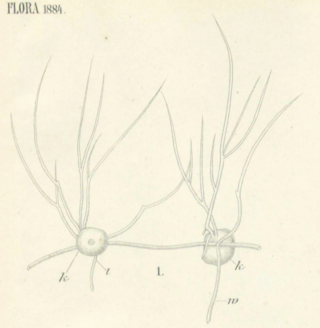Top Qs
Timeline
Chat
Perspective
Tetramyxa
Genus of parasitic cercozoan From Wikipedia, the free encyclopedia
Remove ads
Tetramyxa is a cercozoan protist, member of the plasmodiophores, parasite of several flowering plants.[2] It was first described by Karl von Goebel in 1884, in his work Flora.[1] The genus is characterized by the appearance of resting spores (or cysts) in groups of four.[3]
Remove ads
Taxonomy
There are two accepted species:[2][4]
- Tetramyxa parasitica K. Goebel, 1884 (=Thecaphora ruppiae W. A. Setchell, 1924) – parasite of Zannichellia, Potamogeton and Ruppia roots.
- Tetramyxa marina Y. Lipkin & A. Avidor, 1974 – parasite of Halophila stipulacea petioles.
The following additional species, though recognized as Tetramyxa, are listed as doubtful in some sources:[2]
- Tetramyxa rhizophaga D. Lihnell, 1942 – parasite of Juniperus communis roots.
- Tetramyxa triglochinis M. Molliard, 1909 (=Molliardia triglochinis (M. Molliard) R. Maire & A. Tison, 1911) – parasite of Triglochin maritimum stems, ovaries and stamens.
- Tetramyxa elaeagni Y. Yendo & K. Takase, 1932 – parasite of Elaeagnus multiflora roots.
Remove ads
References
Wikiwand - on
Seamless Wikipedia browsing. On steroids.
Remove ads

